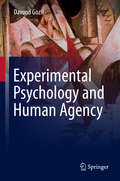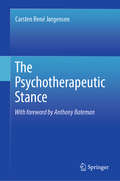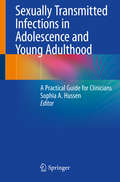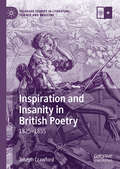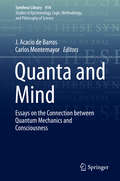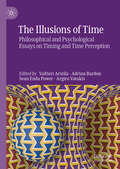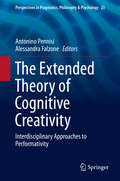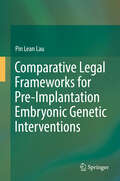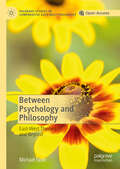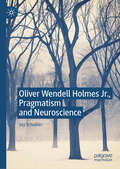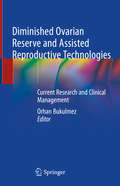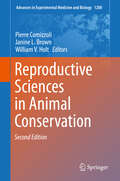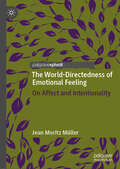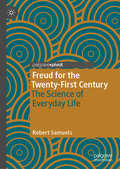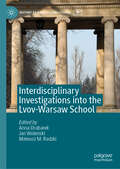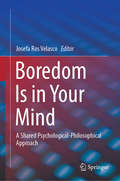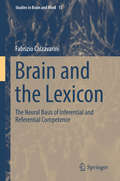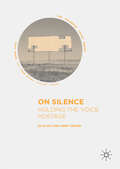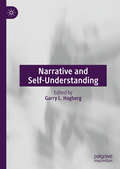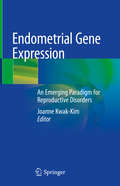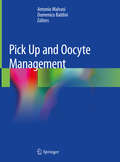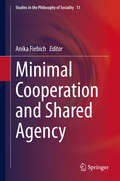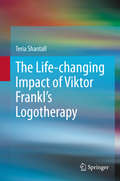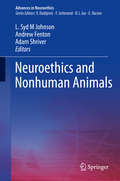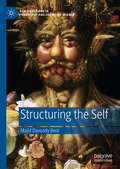- Table View
- List View
Experimental Psychology and Human Agency
by Davood GozliThis book offers an analysis of experimental psychology that is embedded in a general understanding of human behavior. It provides methodological self-awareness for researchers who study and use the experimental method in psychology. The book critically reviews key research areas (e.g., rule-breaking, sense of agency, free choice, task switching, task sharing, and mind wandering), examining their scope, limits, ambiguities, and implicit theoretical commitments. Topics featured in this text include: Methods of critique in experimental research Goal hierarchies and organization of a task Rule-following and rule-breaking behavior Sense of agency Free-choice tasks Mind wandering Experimental Psychology and Human Agency will be of interest to researchers and undergraduate and graduate students in the fields of experimental psychology, cognitive psychology, theoretical psychology, and critical psychology, as well as various philosophical disciplines.
The Psychotherapeutic Stance
by Carsten René JørgensenThis book provides a thorough critique of the dominating medical understanding of psychotherapy and argues for a dynamic relational understanding of psychotherapy, deeply founded in the most important results from empirical psychotherapy research. In the first part, the book critically examines the traditional focus on technical factors in psychotherapy based on available empirical research on the subject. It asks questions about whether specific techniques cure specific diagnoses or therapists and therapeutic relationships that cure persons. Part II of the book argues that the currently dominating medical understanding of psychotherapy must be challenged by a better understanding of psychopathology and psychotherapy that contextualizes the relationship between therapist and the patient. Overall, this book provides a new approach to some of the most important questions in psychotherapy and discusses what it means to think and work psychotherapeutically. The book is highly relevant for professionals in clinical/psychotherapy training and for advanced courses in psychotherapy, including courses on mentalization-based therapy, psychoanalytic psychotherapy and eclectic psychotherapy.
Sexually Transmitted Infections in Adolescence and Young Adulthood: A Practical Guide for Clinicians
by Sophia A. HussenThis book is designed to present a comprehensive and state-of the-art update that covers the pathophysiology, epidemiology, and clinical presentation of the most frequently encountered STIs in adolescence and young adulthood. The introductory sections discuss more general themes including approaches to obtaining a sexual history and exam, concerns of sexual minority youth, ethical and legal considerations, and health disparities in STIs in this population. Subsequent chapters are organized by pathogen such as herpes simplex virus, and human immunodeficiency virus, or clinical syndrome including pelvic inflammatory disease, and vaginitis. Each chapter begins with a case study to illustrate key characteristics of the disease process in question and includes rich illustrations, resources, and guidelines. Written by experts in the field, the text includes a review of epidemiology, pathophysiology, treatment, prevention, and adolescent-specific considerations that is vital to working with this important population. With its transdisciplinary perspective, Sexually Transmitted Infections in Adolescence and Young Adulthood is a unique text that is valuable to infectious disease specialists, adolescent medicine specialists, gynecologists, primary care physicians, advanced practice providers, medical administrative staff, school nurses, sexual health educators, social workers, and public health officials.
Inspiration and Insanity in British Poetry: 1825–1855 (Palgrave Studies in Literature, Science and Medicine)
by Joseph CrawfordThis book explores the ways in which poetic inspiration came to be associated with madness in early nineteenth-century Britain. By examining the works of poets such as Barrett, Browning, Clare, Tennyson, Townshend, and the Spasmodics in relation to the burgeoning asylum system and shifting medical discourses of the period, it investigates the ways in which Britain’s post-Romantic poets understood their own poetic vocations within a cultural context that insistently linked poetic talent with illness and insanity. Joseph Crawford examines the popularity of mesmerism among the writers of the era, as an alternative system of medicine that provided a more sympathetic account of the nature of poetic genius, and investigates the persistent tension, found throughout the literary and medical writings of the period, between the Romantic ideal of the poet as a transcendent visionary genius and the ‘medico-psychological’ conception of poets as mere case studies in abnormal neurological development.
Quanta and Mind: Essays on the Connection between Quantum Mechanics and the Consciousness (Synthese Library #414)
by Carlos Montemayor J. Acacio de BarrosThis edited volume examines aspects of the mind/consciousness that are relevant to the interpretations of quantum mechanics. In it, an international group of contributors focus on the possible connections between quantum mechanics and consciousness. They look at how consciousness can help us with quantum mechanics as well as how quantum mechanics can contribute to our understanding of consciousness. For example, what do different interpretations aimed at solving the measurement problem in quantum mechanics tell us about the nature of consciousness, such as von Neumann's interpretation? Each interpretation has, associated to it, a corresponding metaphysical framework that helps us think about possible “models” of consciousness. Alternatively, what does the nature of consciousness tell us about the role of the observer and time reversibility in the measurement process? The book features 20 papers on contemporary approaches to quanta and mind. It brings together the work of scholars from different disciplines with diverse views on the connections between quanta and mind, ranging from those who are supportive of a link between consciousness and quantum physics to those who are very skeptical of such link. Coverage includes such topics as free will in a quantum world, contextuality and causality, mind and matter interaction, quantum panpsychism, the quantum and quantum-like brain, and the role of time in brain-mind dynamics.
The Illusions of Time: Philosophical and Psychological Essays on Timing and Time Perception
by Adrian Bardon Valtteri Arstila Sean Enda Power Argiro VatakisThis edited collection presents the latest cutting-edge research in the philosophy and cognitive science of temporal illusions. Illusion and error have long been important points of entry for both philosophical and psychological approaches to understanding the mind. Temporal illusions, specifically, concern a fundamental feature of lived experience, temporality, and its relation to a fundamental feature of the world, time, thus providing invaluable insight into investigations of the mind and its relationship with the world. The existence of temporal illusions crucially challenges the naïve assumption that we can simply infer the temporal nature of the world from experience. This anthology gathers eighteen original papers from current leading researchers in this subject, covering four broad and interdisciplinary topics: illusions of temporal passage, illusions and duration, illusions of temporal order and simultaneity, and the relationship between temporal illusions and the cognitive representation of time.
The Extended Theory of Cognitive Creativity: Interdisciplinary Approaches to Performativity (Perspectives in Pragmatics, Philosophy & Psychology #23)
by Antonino Pennisi Alessandra FalzoneThis edited volume focuses on the hypothesis that performativity is not a property confined to certain specific human skills, or to certain specific acts of language, nor an accidental enrichment due to creative intelligence. Instead, the executive and motor component of cognitive behavior should be considered an intrinsic part of the physiological functioning of the mind, and as endowed with self-generative power. Performativity, in this theoretical context, can be defined as a constituent component of cognitive processes. The material action allowing us to interact with reality is both the means by which the subject knows the surrounding world and one through which he experiments with the possibilities of his body. This proposal is rooted in models now widely accepted in the philosophy of mind and language; in fact, it focuses on a space of awareness that is not in the individual, or outside it, but is determined by the species-specific ways in which the body acts on the world. This theoretical hypothesis will be pursued through the latest interdisciplinary methodology typical of cognitive science, that coincide with the five sections in which the book is organized: Embodied, enactivist, philosophical approaches; Aesthetics approaches; Naturalistic and evolutionary approaches; Neuroscientific approaches; Linguistics approaches. This book is intended for: linguists, philosophers, psychologists, cognitive scientists, scholars of art and aesthetics, performing artists, researchers in embodied cognition, especially enactivists and students of the extended mind.
Comparative Legal Frameworks for Pre-Implantation Embryonic Genetic Interventions
by Pin Lean LauThis book discusses the possibilities for the use of international human rights law (and specifically, international biomedical laws related to the protection of human rights and the human genome) to provide a guiding framework for the future regulation of genetic modifications applied to human embryos and other precursor materials, when these are made with the aim of implanting a genetically altered embryo in a woman. The significance and timeliness of the work derives from the recent availability of CRISPR/Cas9 and other gene editing tools, and from lacunae in international law regarding the legality of embryo modification with these tools and appropriate governance structures for the oversight of resulting practices. The emergence of improved genome editing tools like CRISPR/Cas9, holds the promise of eradicating genetic diseases in the near future. But its possible future applications with Pre-Implantation Genetic Diagnosis (PGD) raises a plethora of legal and ethical concerns about "remaking" future human beings. The work aims to address an urgent call, to embed these rising concerns about biomedical advancements into the fundamental tailoring of legal systems. Suitable regulatory approaches, coupled with careful reflection of global biomedical laws and individual constitutional systems must be explored. The Book analyzes the impact of reproductive biomedical technologies on the legal and ethical dimensions of regulatory frameworks in selected constitutional systems like the US, the UK, Australia, Malaysia and Thailand. Employing a comparative law methodology, the work reveals a dynamic intersection between legal cultures, socio-philosophical reasoning and the development of a human rights-based framework in bio-political studies. Navigating towards a truly internationalized biomedical approach to emerging technologies, it presents an understanding why a renegotiation and reinvigoration of a contemporary and "new" universal shared values system in the international human rights discourse is now necessary.
Between Psychology and Philosophy: East-West Themes and Beyond (Palgrave Studies in Comparative East-West Philosophy)
by Michael SloteThis open access book discusses a variety of important but unprecedented ways in which psychology can be useful to philosophy. The early chapters illustrate this theme via comparisons between Chinese and Western philosophy. It is argued that the Chinese notion of a heart-mind is superior to the Western concept of mind, but then, more even-handedly, the relative strengths and weaknesses of Chinese and Western thought overall are critically examined. In later chapters, the philosophical uses of psychology are treated more specifically in relation to major issues in Western philosophy. Michael Slote shows that empathy and emotion play a role in speech acts (like assertion and thanking) that speech act theory has totally ignored. Similarly, he treats the age-old question of whether justice pays using psychological material that has not previously been recognized. Finally, the implications of psychological egoism are discussed in terms of some new psychological and, indeed, human distinctions. Human life is pervaded by instincts and aspirations that are neither egoistic nor altruistic, and recognizing that fact can help put egoism in its place. It is less of a challenge to morality than we have realized.
Oliver Wendell Holmes Jr., Pragmatism and Neuroscience
by Jay SchulkinThis book explores the cultures of philosophy and the law as they interact with neuroscience and biology, through the perspective of American jurist Oliver Wendell Holmes’ Jr., and the pragmatist tradition of John Dewey. Schulkin proposes that human problem solving and the law are tied to a naturalistic, realistic and an anthropological understanding of the human condition. The situated character of legal reasoning, given its complexity, like reasoning in neuroscience, can be notoriously fallible. Legal and scientific reasoning is to be understood within a broader context in order to emphasize both the continuity and the porous relationship between the two. Some facts of neuroscience fit easily into discussions of human experience and the law. However, it is important not to oversell neuroscience: a meeting of law and neuroscience is unlikely to prove persuasive in the courtroom any time soon. Nevertheless, as knowledge of neuroscience becomes more reliable and more easily accepted by both the larger legislative community and in the wider public, through which neuroscience filters into epistemic and judicial reliability, the two will ultimately find themselves in front of a judge. A pragmatist view of neuroscience will aid and underlie these events.
Diminished Ovarian Reserve and Assisted Reproductive Technologies: Current Research and Clinical Management
by Orhan BukulmezThis book brings together the most current research and the latest clinical approaches to the management of diminished ovarian reserve (DOR), one of the largest segments of the IVF patient population, both in the advanced reproductive age group as well as poor responders. Opening with a review of the definition and scope of the problem, as well as the current understanding of the natural history of DOR, subsequent chapters in part I outline dietary, hormonal, traditional supplements and conventional methods used to stimulate ovaries and improve ART outcomes. The main segment of chapters, comprising part II, present minimal and mild stimulation protocols and alternatives, frozen embryo transfer preparation, trigger agents and post-trigger testing, embryo culture and endometrial considerations, and a review of clinical outcomes. Part III discusses the utilization of contemporary technologies in the treatment of DOR, including fresh vs. frozen embryo transfer, cryopreservation and comprehensive chromosomal analysis. Future prospects are presented in part IV, such as the artificial oocyte and ovary development, early-age oocyte freezing, ovarian cortical tissue freezing and activation of the ovarian cortex. Utilizing the latest evidence and authored by an international array of thought leaders, Diminished Ovarian Reserve and Assisted Reproductive Technologies is an excellent resource for reproductive medicine and REI specialists, IVF lab professionals, and students and residents in these areas.
Reproductive Sciences in Animal Conservation: Progress And Prospects (Advances in Experimental Medicine and Biology #1200)
by William V. Holt Janine L. Brown Pierre ComizzoliThis second edition emphasizes the environmental impact on reproduction, with updated chapters throughout as well as complete new chapters on species such as sharks and rays. This is a wide-ranging book that will be of relevance to anyone involved in species conservation, and provides critical perspectives on the real utility of current and emerging reproductive sciences.Understanding reproductive biology is centrally important to the way many of the world’s conservation problems should be tackled. Currently the extinction problem is huge, with up to 30% of the world’s fauna being expected to disappear in the next 50 years. Nevertheless, it has been estimated that the global population of animals in zoos encompasses 12,000 – 15,000 species, and we anticipate that every effort will be made to preserve these species for as long as possible, minimizing inbreeding effects and providing the best welfare standards available. Even if the reproductive biology community cannot solve the global biodiversity crisis for all wild species, we should do our best to maintain important captive populations. Reproductive biology in this context is much more than the development of techniques for helping with too little or too much breeding. While some of the relevant techniques are useful for individual species that society might target for a variety of reasons, whether nationalistic, cultural or practical, technical developments have to be backed up by thorough biological understanding of the background behind the problems.
The World-Directedness of Emotional Feeling: On Affect and Intentionality
by Jean Moritz MüllerThis book engages with what are widely recognized as the two core dimensions of emotion. When we are afraid, glad or disappointed, we feel a certain way; moreover, our emotion is intentional or directed at something: we are afraid of something, glad or disappointed about something. Connecting with a vital strand of recent philosophical thinking, Müller conceives of these two aspects of emotion as unified. Examining different possible ways of developing the view that the feeling dimension of emotion is itself intentional, he argues against the currently popular view that it is a form of perception-like receptivity to value. Müller instead proposes that emotional feeling is a specific type of response to value, an affective ‘position-taking’. This alternative conceives of emotional feeling as intimately related to our cares and concerns. While situating itself within the analytic-philosophical debate on emotion, the discussion crucially draws on ideas from the early phenomenological tradition and thinks past the theoretical strictures of many contemporary approaches to this subject. The result is an innovative view of emotional feeling as a thoroughly personal form of engagement with value.
Freud for the Twenty-First Century: The Science of Everyday Life
by Robert SamuelsThis book places Freud’s theory of the reality principle in relation to both everyday experience and global issues of the 21st century and illustrates how it may be practically applied. Arguing against more critical recent accounts of Freud’s science, the author seeks to show how one might apply the scientific method to everyday life. It demonstrates how Freud contributes to a better understanding of reason and how this in turn can be used to unravel the role of unreason in both politics and personal relationships. Including critical examinations of topics such as Narcissism, Victimhood and Empathy, this engaging reappraisal of Freud’s relevance to contemporary life offers fresh insights for psychology, psychoanalysis and cultural theory; as well as practical guidance for a general reader.
Interdisciplinary Investigations into the Lvov-Warsaw School (History of Analytic Philosophy)
by Jan Woleński Anna Drabarek Mateusz M. RadzkiThis book presents the heritage of the Lvov-Warsaw School from both the historical and the philosophical perspective. The historical view focuses on the beginnings and the dramatic end of the School brought about by the outbreak of World War II. The philosophical view, on the other hand, encompasses a broad spectrum of issues, including logical, epistemological, axiological, and psychological problems, revealing the interdisciplinary nature of studies carried out by Kazimierz Twardowski and his students.With thirteen diverse and original essays this volume is split into three parts: History, Culture and Axiology; Psychology; and Logic and Methodology. Exploring not only the history of philosophy represented by the Lvov-Warsaw school, the book also reflects on the condition of contemporary philosophy from the perspective of concepts developed by its representatives. Furthermore, the studies presented in this book delve into problems of contemporary science and its distinctive interdisciplinary character. This volume is, therefore, not only a collection of analyses of the Lvov-Warsaw School philosophy, but also an investigation into the interdisciplinarity of science and philosophy itself.
Boredom Is in Your Mind: A Shared Psychological-Philosophical Approach
by Josefa Ros VelascoThis book offers a unique perspective on the topic of boredom, with chapters written by diverse representatives of various mental health disciplines and philosophical approaches. On one hand, studying boredom involves the mental processes of attention, memory, perception, creativity, or language use; on the other, boredom can be understood by taking into account many pathological conditions such as depression, stress, and anxiety. This book seeks to fill the knowledge gap in research by discussing boredom through an interdisciplinary dialogue, giving a comprehensive overview of the past and current literature within boredom studies, while discussing the neural bases and causes of boredom and its potential consequences and implications for individual and social well-being. Chapters explore the many facets of boredom, including:Understanding the cognitive-affective mechanisms underlying experiences of boredomPhilosophical perspectives on boredom, self-consciousness, and narrativeHow boredom shapes both basic and complex human thoughts, feelings, and behavior Analyzing boredom within Freudian and Lacanian frameworks Boredom Is in Your Mind: A Shared Psychological-Philosophical Approach is a pioneering work that brings together threads of cross-disciplinary boredom research into one comprehensive resource. It is relevant for graduate students and researchers in myriad intersecting disciplines, among them cognitive psychology, cognitive neurosciences, and clinical psychology, as well as philosophy, logic, religion, and other areas of the humanities and social sciences.
Brain and the Lexicon: The Neural Basis of Inferential and Referential Competence (Studies in Brain and Mind #15)
by Fabrizio CalzavariniThis monograph offers a novel, neurocognitive theory concerning words and language. It explores the distinction between inferential and referential semantic competence. The former accounts for the relationship of words among themselves, the latter for the relationship of words to the world. The author discusses this distinction at the level of the human brain on both theoretical and neuroscientific grounds. In addition, this investigation considers the relation between the inf/ref neurocognitive theory and other accounts of semantic cognition proposed in the field of neurosemantics, as well as some potential implications of the theory for clinical neuroscience and the philosophy of semantics. Overall, the book offers an important contribution to the debate about lexical semantic competence. It combines a strong philosophical and linguistic background with a comprehensive and critical analysis of neurosemantic literature. Topics discussed lie at the intersection of philosophical semantics, linguistics, neurolinguistics, cognitive science, artificial intelligence, cognitive neuroscience, and clinical psychology. Due to its interdisciplinary orientation, coverage is rich in introductory remarks and not overly technical, therefore it is accessible to non-experts as well.
On Silence: Holding the Voice Hostage (The Palgrave Lacan Series)
by Ed Pluth Cindy ZeiherThis book promotes a Lacanian approach to silence, arguing that Lacanian psychoanalysis is distinctive for putting a high value on both silence and language. Unlike other disciplines and discourses the authors do not treat silence as a mystical-impossible beyond, at the cost of demoting the value of language and thought. Rather than treating silence with awe and wonder, this book puts silence to work, and it does so in order to deal with the inevitable alienation that comes with becoming speaking-beings. This illuminating book will be of great interest to scholars of Lacan and the psychosocial, as well as more broadly to philosophers and linguists alike.
Narrative and Self-Understanding
by Garry L. HagbergThis exciting new edited collection bridges the gap between narrative and self-understanding. The problem of self-knowledge is of universal interest; the nature or character of its achievement has been one continuing thread in our philosophical tradition for millennia. Likewise the nature of storytelling, the assembly of individual parts of a potential story into a coherent narrative structure, has been central to the study of literature. But how do we gain knowledge from an artform that is by definition fictional, by definition not a matter of ascertained fact, as this applies to the understanding of our lives? When we see ourselves in the mimetic mirror of literature, what we see may not just be a matter of identifying with a single protagonist, but also a matter of recognizing long-form structures, long-arc narrative shapes that give a place to – and thus make sense of – the individual bits of experience that we place into those structures. But of course at precisely this juncture a question arises: do we make that sense, or do we discover it? The twelve chapters brought together here lucidly and steadily reveal how the matters at hand are far more intricate and interesting than any such dichotomy could accommodate. This is a book that investigates the ways in which life and literature speak to each other.
Endometrial Gene Expression: An Emerging Paradigm for Reproductive Disorders
by Joanne Kwak-KimThe endometrium goes through cyclical changes under the influence of hormones, and immune effectors in the endometrium change their populations cyclically as well. Dynamic changes in immune effectors determine endometrial cytokine and chemokine milieus and, consequently, the endometrial immune response. Endometrial immune responses have been shown to be important for trophoblast invasion and early pregnancy. Indeed, dysregulated endometrial inflammatory immune responses are associated with reproductive failures, such as recurrent pregnancy losses, repeated implantation failure, and gynecological diseases with oncogenic potential. Hence, the investigation of endometrial gene expression may predict infertility, gynecological and oncological conditions. This book presents the state of the art in endometrial gene expression as well as recent developmental findings relating to reproduction and reproductive disorders. It begins with a review of the genetic regulation of urogenital tract formation and molecular mechanism underlying the physiology of menstrual cycle before moving on to the current and emerging technological advances in molecular biology. Endometrial gene expressions of immune inflammatory conditions, viral infection, metabolic and nutritional conditions, and reproductive disorders are then presented in following chapters. Examples of the use and interpretation of gene expression in clinical scenarios including recurrent pregnancy losses, infertility and multiple implantation failures are presented with currently available endometrial gene analysis.Utilizing the latest evidence and clinical guidelines, Endometrial Gene Expression will be a cutting-edge resource for gynecologist, reproductive immunologist, reproductive endocrinologists, obstetrician, maternal fetal medicine specialist and other health care providers in the field of reproductive medicine.
Pick Up and Oocyte Management
by Antonio Malvasi Domenico BaldiniThis richly illustrated book focuses on one of the specific and crucial steps of the Medically Assisted Procreation techniques that is often overlooked: the oocyte pick-up. Enhanced by a large number of high-quality pictures, this atlas of oocyte retrieval comprehensively describes important aspects such as the setting of the ultrasonic equipment, the choice of needle, the layout of the devices in the room and the technique to be used, which, if not properly handled, can lead to erroneous behaviors. The original and detailed illustrations, mainly microscopic images and explanatory drawings, help readers to better understand how to manage all the phases of the ovarian pick-up and oocyte management. This practical atlas provides a valuable guide for all specialists who want to improve their skills and gain confidence with the MPA techniques.
Minimal Cooperation and Shared Agency (Studies in the Philosophy of Sociality #11)
by Anika FiebichThis volume examines minimality in cooperation and shared agency from various angles. It features essays written by top scholars in the philosophy of mind and action. Taken together, the essays provide a genuine contribution to the contemporary joint action debate.The main accounts in this debate present sufficient rather than necessary or minimal criteria for there to be cooperation. Much discussion in the debate deals with robust rather than more attenuate and simple cases of cooperation or shared agency. Focusing on such minimal cases, however, may help to explain how cooperation comes into existence and how minimal cooperation interrelates with more complex cases of cooperation. The contributors discuss minimality in cooperation by focusing on particular aspects. For example, they consider how social roles might deliver minimal cooperation constraints or what the minimal contextual criteria are for cooperation to emerge.Readers will find the answers to these and other questions: What is minimally cooperative behavior? By what steps could full members of a society organized by conventions, norms and institutions be constructed from creatures with minimal social skills and cognitive abilities? What do we experience of actions when we act together with a purpose?
The Lıfe-changıng Impact of Vıktor Frankl's Logotherapy
by Teria ShantallThis book provides an in-depth analysis of of the logotherapy of Viktor Frankl and delves into the spiritual depths of an inherent search for meaning in life. Written by a highly experienced and competent logotherapist trained by Frankl himself, this book is excitingly new and unique in that it takes the reader, in the role of a client accompanied by the author in the role of the therapist, through the unfolding phase-by-phase process of logotherapy. Logotherapy is explored as a depth and as a height psychology. From a provoked will to meaning out of the depths of a spiritual unconscious, the author takes the search for meaning to the ultimate heights in the achievement of human greatness. This book brings Frankl’s own profound life’s orientation back to life and, in its reader-friendly style, has the freshness of Frankl’s own way of writing. It is written in a refreshingly simple and straightforward style for easy accessibility to a wide readership. It includes cases studies and exercises for readers and is meant for use in logotherapy courses worldwide. Additionally, it will appeal to laypersons seeking a deeper meaning to their lives, psychology students and mental health professionals alike.
Neuroethics and Nonhuman Animals (Advances in Neuroethics)
by Andrew Fenton L. Syd M Johnson Adam ShriverThis edited volume represents a unique addition to the available literature on animal ethics, animal studies, and neuroethics. Its goal is to expand discussions on animal ethics and neuroethics by weaving together different threads: philosophy of mind and animal minds, neuroscientific study of animal minds, and animal ethics. Neuroethical questions concerning animals’ moral status, animal minds and consciousness, animal pain, and the adequacy of animal models for neuropsychiatric disease have long been topics of debate in philosophy and ethics, and more recently also in neuroscientific research. The book presents a transdisciplinary blend of voices, underscoring different perspectives on the broad questions of how neuroscience can contribute to our understanding of nonhuman minds, and on debates over the moral status of nonhuman animals. All chapters were written by outstanding scholars in philosophy, neuroscience, animal behavior, biology, neuroethics, and bioethics, and cover a range of issues and species/taxa. Given its scope, the book will appeal to scientists and students interested in the debate on animal ethics, while also offering an important resource for future researchers. Chapter 13 is available open access under a CC BY 4.0 license at link.springer.com.
Structuring the Self (New Directions in Philosophy and Cognitive Science)
by Majid Davoody BeniThis book presents a unified account of the self, based on a network of knowledge sourced from several scientific accounts of selfhood. Beni constructs his ontological account of the self from the common structure that underpins the theoretical diversity that is manifested in rival and sometimes incompatible scientific accounts of the self and its aspects. The enterprise is inspired by recent structural realist theories in the philosophy of science, specifying the basic structure of the self, and explaining how representational, phenomenal, and social aspects of the self are embodied within this structure.
